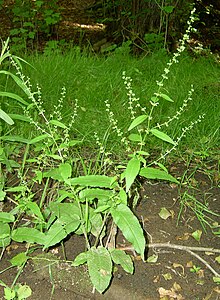Grove dock
| Grove dock | ||||||||||||
|---|---|---|---|---|---|---|---|---|---|---|---|---|

Grove dock ( Rumex sanguineus ) |
||||||||||||
| Systematics | ||||||||||||
|
||||||||||||
| Scientific name | ||||||||||||
| Rumex sanguineus | ||||||||||||
| L. |
The grove dock or blood dock ( Rumex sanguineus ) is a species from the knotweed family (Polygonaceae). It can be found in Central Europe in damp, sometimes disturbed forest locations.
description
The grove dock is a perennial hemicryptophyte and reaches a height of 50 to 80 (rarely 120) centimeters. The stems are often reddish.
The basal leaves are oblong-egg-shaped and have a heart-shaped to truncated base. The petiole is as long as the blade . The blade is dark green, up to 14 inches long and up to 6 inches wide. The upper stem leaves are rounded or wedge-shaped at the base.
The inflorescence is leafed to the middle. The flower clusters are rather loose-flowered and separated from each other. Most of the flowers are hermaphroditic. In cases where the flowers are unisexual, the plants are at least monoecious . The outer bracts lie against the inner ones at the fruiting time. The inner ones are narrowly elongated, 3 to 3.8 millimeters long and 0.5 to 1.5 millimeters wide. You are thin-skinned. Only the front has a large, spherical callus. The remaining bracts are calloused or have only a thickened middle nerve.
The fruits are black-brown nuts 1.6 to 2 millimeters long . The fruit stalks are significantly longer than the inner bracts.
The number of chromosomes is 2n = 20.
Occurrence
The area of the Hain-Ampfers comprises the submeridional and temperate zone in the ocean-toned Eurasia, i.e. above all Western and Central Europe, the Caucasus region and Iran. In North America the species is introduced as a neophyte . It grows from the planar to the montane altitudinal zone ; in Styria it rises up to 750 m , on the Swabian Alb up to 1000 m above sea level. NN .
The sorrel prefers alluvial forests and other humid hardwood forests; it thrives in woody banks, on forest fringes, wet roadsides and on wooded fields. Mostly it occurs on waterlogged, nutrient-rich, lime-poor and humus-rich loam and clay soils. It is a waterlogging and soil compaction indicator. It is a character species of the Carici remotae-Fraxinetum, but also occurs in other societies of the Alno-Ulmion association, in societies of the Alliarion, Atropion or the order Fagetalia.
literature
- Manfred A. Fischer, Wolfgang Adler, Karl Oswald: Excursion flora for Austria, Liechtenstein and South Tyrol . 2nd, improved and enlarged edition. State of Upper Austria, Biology Center of the Upper Austrian State Museums, Linz 2005, ISBN 3-85474-140-5 .
- Rudolf Schubert , Klaus Werner, Hermann Meusel (eds.): Excursion flora for the areas of the GDR and the FRG . Founded by Werner Rothmaler. 13th edition. tape 2 : vascular plants . People and knowledge, Berlin 1987, ISBN 3-06-012539-2 .
- Siegmund Seybold (Ed.): Schmeil-Fitschen interactive . CD-ROM, version 1.1. Quelle & Meyer, Wiebelsheim 2002, ISBN 3-494-01327-6 .
Individual evidence
- ↑ Rumex sanguineus at Tropicos.org. In: IPCN Chromosome Reports . Missouri Botanical Garden, St. Louis
- ^ Rumex in the Germplasm Resources Information Network (GRIN), USDA , ARS , National Genetic Resources Program. National Germplasm Resources Laboratory, Beltsville, Maryland. Retrieved August 17, 2017.
- ^ Erich Oberdorfer : Plant-sociological excursion flora for Germany and neighboring areas . With the collaboration of Angelika Schwabe and Theo Müller. 8th, heavily revised and expanded edition. Eugen Ulmer, Stuttgart (Hohenheim) 2001, ISBN 3-8001-3131-5 , pp. 329-330 .
Web links
- Grove dock. In: FloraWeb.de.
- Distribution map for Germany. In: Floraweb .
- Rumex sanguineus L. In: Info Flora , the national data and information center for Swiss flora .
- Distribution in the northern hemisphere from: Eric Hultén, Magnus Fries: Atlas of North European vascular plants. 1986, ISBN 3-87429-263-0 at Den virtuella floran. (swed.)
- Thomas Meyer: Data sheet with identification key and photos at Flora-de: Flora von Deutschland (old name of the website: Flowers in Swabia )


